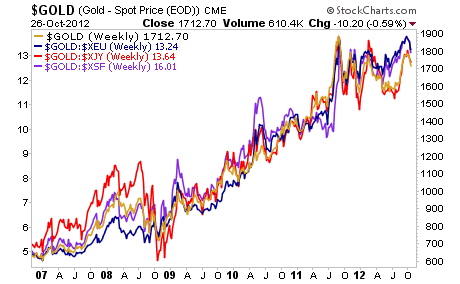Since the Financial Crisis erupted in 2007, the US Federal Reserve has engaged in dozens of interventions/ bailouts to try and prop up the financial system. Now, I realize that everyone knows the Fed is “printing money.” However, when you look at the list of bailouts/ money pumps it’s absolutely staggering how much money the Fed has thrown around.
Here’s a recap of some of the larger Fed moves during the Crisis:
- Cutting interest rates from 5.25-0.25% (Sept ’07-today).
- The Bear Stearns deal/ taking on $30 billion in junk mortgages (Mar ’08).
- Opening various lending windows to investment banks (Mar ’08).
- Hank Paulson spends $400 billion on Fannie/ Freddie (Sept ’08).
- The Fed takes over insurance company AIG for $85 billion (Sept ’08).
- The Fed doles out $25 billion for the automakers (Sept ’08)
- The Feds kick off the $700 billion TARP program (Oct ’08)
- The Fed buys commercial paper from non-financial firms (Oct ’08)
- The Fed offers $540 billion to backstop money market funds (Oct ’08)
- The Fed agrees to back up to $280 billion of Citigroup’s liabilities (Oct ’08).
- $40 billion more to AIG (Nov ’08)
- The Fed backstops $140 billion of Bank of America’s liabilities (Jan ’09)
- Obama’s $787 Billion Stimulus (Jan ’09)
- QE 1 buys $1.25 trillion in Treasuries and mortgage debt (March ’09)
- QE lite buys $200-300 billion of Treasuries and mortgage debt (Aug ’10)
- QE 2 buys $600 billion in Treasuries (Nov ’10)
- Operation Twist 2 (Nov ’11)
- QE 3 ($40 billion in MBS monetization per month)
And this is just a brief recap. I’m almost certain I left something out. Indeed, between 2008 and today, the US Federal Reserve has grown its balance sheet from $800 billion to almost $3 TRILLION in size (larger than the economies of Brazil, the UK, and France).
The Fed is not the only bank to engage in such profligate policies either. Thanks to its bond purchases as well as its LTRO 1 and LTRO 2 schemes, the European Central Bank (ECB) has in fact grown its balance sheet even larger than the Fed.
| Country | GDP |
| European Union | $16 trillion |
| United States of America | $14.5 trillion |
| China | $5.8 trillion |
| Japan | $5.4 trillion |
| European Central Bank | $3.8 trillion |
| Germany | $3.2 trillion |
| US Federal Reserve | $2.8 trillion |
| France | $2.5 trillion |
| United Kingdom | $2.2 trillion |
As a result of this, inflation hedges, particularly Gold have been soaring. Gold was, is, and always will be THE ultimate storehouse of value. Mankind was prizing it long before the concept of stocks, mutual funds, or paper money even existed.
So with world central banks printing paper money day and night it is no surprise that Gold is now emerging as the ultimate currency: one that cannot be printed. Indeed, Gold has broken out against ALL major world currencies in the last ten years. The below chart prices Gold in Dollars (Gold), Euros (Blue), Japanese Yen (Red) and Swiss Francs (Purple):
Now, a lot of commentators have noted that gold is already trading above its 1980 high ($850 an ounce). What they fail to note is that thanks to inflation, $1 in the ‘70s is worth a LOT MORE than a $1 today.
|
$1 in… |
Is Worth Today |
|
1970 |
$5.49 |
|
1980 |
$2.58 |
For gold to hit a new all time high adjusted for inflation, it would have to clear at least $2,193 per ounce. If you go by 1970 dollars (when gold started its last bull market) it’d have to hit $4,666 per ounce.
If you do not already have exposure to Gold, consider getting some now. If you do decide to buy, I strongly urge you to buy actual physical bullion because it is not clear that the various Gold ETFs actually own the bullion they claim to
On that note, we just published a Special Portfolio of unique inflation hedges: investments that will not only maintain their purchasing power but will outperform even Gold and Silver as the Fed and ECB debase their respective fiat currencies.
We’re talking about investments of extraordinary value that 99% of investors are unaware of: asset plays trading at massive discounts to their underlying values. The kind of investments that can show you double-digit returns in a very short period.
This portfolio will be made available only to subscribers of our Private Wealth Advisory newsletter. The last time we opened a similar portfolio, we saw gains of 28%, 41% and 42% in a matter of months. We expect similar returns this time around as well.
To find out more about Private Wealth Advisory and get on board for this Special Inflation Portfolio…
Phoenix Capital Research





